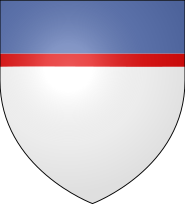
In English-language heraldry, the fillet is considered a diminutive of the chief. It is defined as occupying one fourth the width of the chief and typically positioned at its bottom edge.[1] When so positioned the chief is blazoned as supported by the fillet; but, when the chief is charged by the fillet, as when the fillet positioned at its top edge[2] or middle, the chief is blazoned as surmounted.[3] Another term for the former, supported, is sustained.[4] In French heraldry, terms for this charge are divise[5] and filet en chef.[6] The term chef retrait has also been used.[7] The fillet or divise placed beneath the chief is of a different tincture than the field,[8] evidently to avoid violations of the rule of tincture (see Berry 1828[9]).
There are other uses of the English fillet that are similar to its use above as diminutive of the chief. The term is used by some for a diminutive of the fess narrower than the bar, as a synonym for barrulet.[10] It is also used by some more generally for a narrow band as charge that can be positioned variously on the field—as a diminutive of the bend, as synonym of riband[11] as well as the fess, as synonym of barrulet. This latter use parallels that of the cognate term filet in French heraldry, where it is possible to speak of the filet "en fasce, en pal, en bande, en barre, en croix, en sautoir, en chevron, en parle" (fillet in fess, in pale, in bend, in bend sinister, in cross, in saltire, in chevron, in pall).[12] (See #Fillet as adjective below.)
Such uses of the term fillet in English (or filet in French) often employ it as term for a component element of other devices such as the cross parted and fretted,[13] the ordinary the fret, or the variation of the field fretty.[14] 'Fretted' and 'fretty' refer to the interlacing of the fillets.[15] The Jumelle (Eng. bar gemel, etc.) and Tierce are other charges also said to be composed of filets.[16] The cottise, or cost, has been described as having the "appearance of a fillet placed beside the principal ordinary"[17] and at least one author terms it a fillet.[18] The pentagram has even been described as a "star reduced to an interlaced fillet".[19]
This use of the term, as the diminutive of an ordinary or component of a complex charge, is to be distinguished from other uses of the term fillet in heraldry. See section #Other uses of fillet in a heraldic context below.
- ^ Manual of Heraldry. London: Jeremiah How. 1846. p. 18.
- ^ Elvin, Charles Norton (1889). A dictionary of heraldry : with upwards of two thousand five hundred illustrations. London: Kent and Co. p. xviii.
- ^ Berry, William (1828). Encyclopaedia heraldica; or, Complete dictionary of heraldry. London: Sherwood, Gilbert and Piper. p. CHI-CHU.
- ^ Copinger, Walter Arthur (1910). Heraldry Simplified: An Easy Introduction to the Science and a Complete Body of Armory, Including the Arts of Blazoning and Marshalling, with Full Directions for the Making of Pedigrees and Information as to Records &c. Manchester: The University Press. p. 373. Retrieved 23 October 2024.
- ^ de Mailhol, Dayre (1895). Dictionnaire historique et héraldique de la noblesse française. Paris: Direction & Redaction [Impr. Ch. Lépice]. p. 90.
- ^ Woodward, John (1896). A Treatise on Heraldry, British and Foreign With English and French Glossaries · Volume 1. Edinburgh and London: W. & A.K. Johnston. p. 473.
- ^ Gough, Henry; Parker, James (1894). A Glossary of Terms Used in Heraldry (New ed.). Oxford and London: J. Parker and Co. p. 112.
- ^ Owen, W. (1754). A New and Complete Dictionary of Arts and Sciences, Vol. 2. London. p. 1228.
- ^ Berry, William (1828). Encyclopaedia heraldica; or, Complete dictionary of heraldry. London: Sherwood, Gilbert and Piper. p. FIG-FIR.
- ^ Gough, Henry; Parker, James (1894). A Glossary of Terms Used in Heraldry (New ed.). Oxford and London: J. Parker and Co. p. 157.
- ^ Woodward, John; Burnett, George (1892). A treatise on heraldry British and foreign : with English and French glossaries. Edinburgh: W. & A.K. Johnston. p. 133.
- ^ Société héraldique et généalogique de France; de La Roque, Louis (1879). Bulletin héraldique de France ou Revue historique de la noblesse paraissant sous la direction de Louis de la Roque · Volume 1. Paris: Bureau de la Société héraldique et généalogique de France. p. 516. Retrieved 3 April 2024.
- ^ Gough, Henry; Parker, James (1894). A Glossary of Terms Used in Heraldry (New ed.). Oxford and London: J. Parker and Co. p. 157.
- ^ Newton, William (1846). Display of Heraldry. London: William Pickering. p. 61.
- ^ Aveling, S.T. (1892). Heraldry, Ancient and Modern: Including Boutell's Heraldry. London: W. W. Gibbings. p. 40.
- ^ Gheusi, Pierre-Barthélemy (1892). Le blason héraldique: Manuel nouveau de l'art héraldique de la science du blason et de la polychromie féodale d'après les règles du moyen age avec 1300 gravures et un armorial. Paris: Librairie de Firmin Didot et c. p. 56.
- ^ Jenkins, Robert Charles (1886). Heraldry, English and Foreign: With a Dictionary of Heraldic Terms. London: Kegan Paul, Trench & Co. p. 80. Retrieved 21 March 2024.
- ^ Nisbet, Alexander (1804). A System of Heraldry, Speculative and Practical: with the True Art of Blazon ... Illustrated with Suitable Examples of Armorial Figures, and Achievements of the Most Considerable Surnames and Families in Scotland (Second ed.). Edinburgh: Alex Lawrie & Co. p. 89.
- ^ Gheusi, Pierre-Barthélemy (1892). Le blason héraldique: Manuel nouveau de l'art héraldique de la science du blason et de la polychromie féodale d'après les règles du moyen age avec 1300 gravures et un armorial. Paris: Librairie de Firmin Didot et c. p. 151.